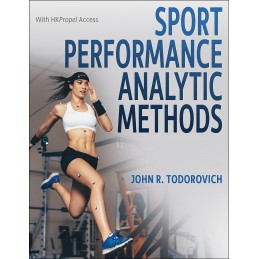In todays sports world, decision makers, coaches, trainers, and athletes readily embrace sport performance analytics (SPA) and expect decisions to be based on such analyses. Organizations adept at collecting data, analyzing data, and applying findings enjoy a competitive advantage on the field—and a positive impact on the bottom line. For sport management students with a passion for sports and an aptitude for analytics, SPA presents an enticing career choice—one in high demand.
Sport Performance Analytic Methods With HKPropel Access not only introduces students to the field of sport performance analytics but also walks them through the entire SPA process. This unparalleled approach equips students to employ SPA tools and techniques to make informed decisions affecting organization performance and success.
The content of the book is driven by the SPA model, a seven-step process providing a guided pathway for conducting SPA analyses::
- Establish what you want to know
- Define the data you will collect
- Determine the data collection process and collect data
- Analyze the data
- Interpret the results
- Present the results
- Make data-based decisions
The opening chapter emphasizes the importance of establishing the SPA objectives. The focus then shifts to understanding foundational data concepts, with discussions on quantitative and qualitative data, types and scale of variables, temporal aspects of data, process and product data, and validity and reliability of data. Methods and tools for collecting data are explored next, including technology-assisted data acquisition tools such as wearable devices and biometric sensing devices.
Students will then examine quantitative statistical concepts that can be used to analyze data and even help make predictions about future player or team performance. Key concepts include descriptive statistics, data sets, inferential statistics, group comparisons, and linear regressions.
The text also addresses techniques for collecting and analyzing qualitative data—including observation, content, narrative, discourse, thematic, and grounded theory analyses—ensuring that all forms of data are considered to produce successful outcomes.
Finally, the text demonstrates how to present SPA data in a format useful to apply in decision making. Students learn how coaches and performance data analysts use data to inform pre- and postcompetition strategic and tactical plans, make in-game decisions, evaluate team and individual performance, and make decisions for teams, players, and organizations.
Related online resources, delivered via HK
Propel, provide students with hands-on learning tools. In addition to descriptions of the primary SPA software packages, included are eight learning modules that allow students to go through various statistical procedures step by step, inputting results, checking for accuracy, and improving performance.
With
Sport Performance Analytic Methods, students will gain a solid understanding of the principles made famous by Moneyball, and they will learn to use sport analytics to improve sport performance outcomes.
Note:: A code for accessing HK
Propel is included with all new print books.


 Dostawa
Dostawa
 Płatność
Płatność
 Zwroty
Zwroty
